Counseling Young People and Adults: Differences and Ethical Challenges
VerifiedAdded on 2022/09/06
|10
|2483
|16
Essay
AI Summary
This essay provides a comprehensive comparison between counseling young people and adults, highlighting the distinct approaches and considerations required for each group. It explores the key differences in the issues addressed, such as substance abuse, bullying, and relationship problems, and how these issues manifest differently across age groups. The essay also examines the ethical and moral challenges faced by counselors and teachers, including maintaining boundaries, ensuring equal access to counseling, and respecting patient differences. It discusses the various counseling approaches, including psychodynamic, humanistic, and behavioral, and how these are applied to address the unique needs of young people and adults. The essay emphasizes the importance of understanding these differences to provide effective and ethical counseling services. The essay concludes by highlighting the importance of counseling for adolescents and the various reasons they seek professional help.

Running Head: BUSINESS AND CORPORATION LAW 0
Psychology
Counselling
12/28/2019
Student’s Name
Psychology
Counselling
12/28/2019
Student’s Name
Paraphrase This Document
Need a fresh take? Get an instant paraphrase of this document with our AI Paraphraser
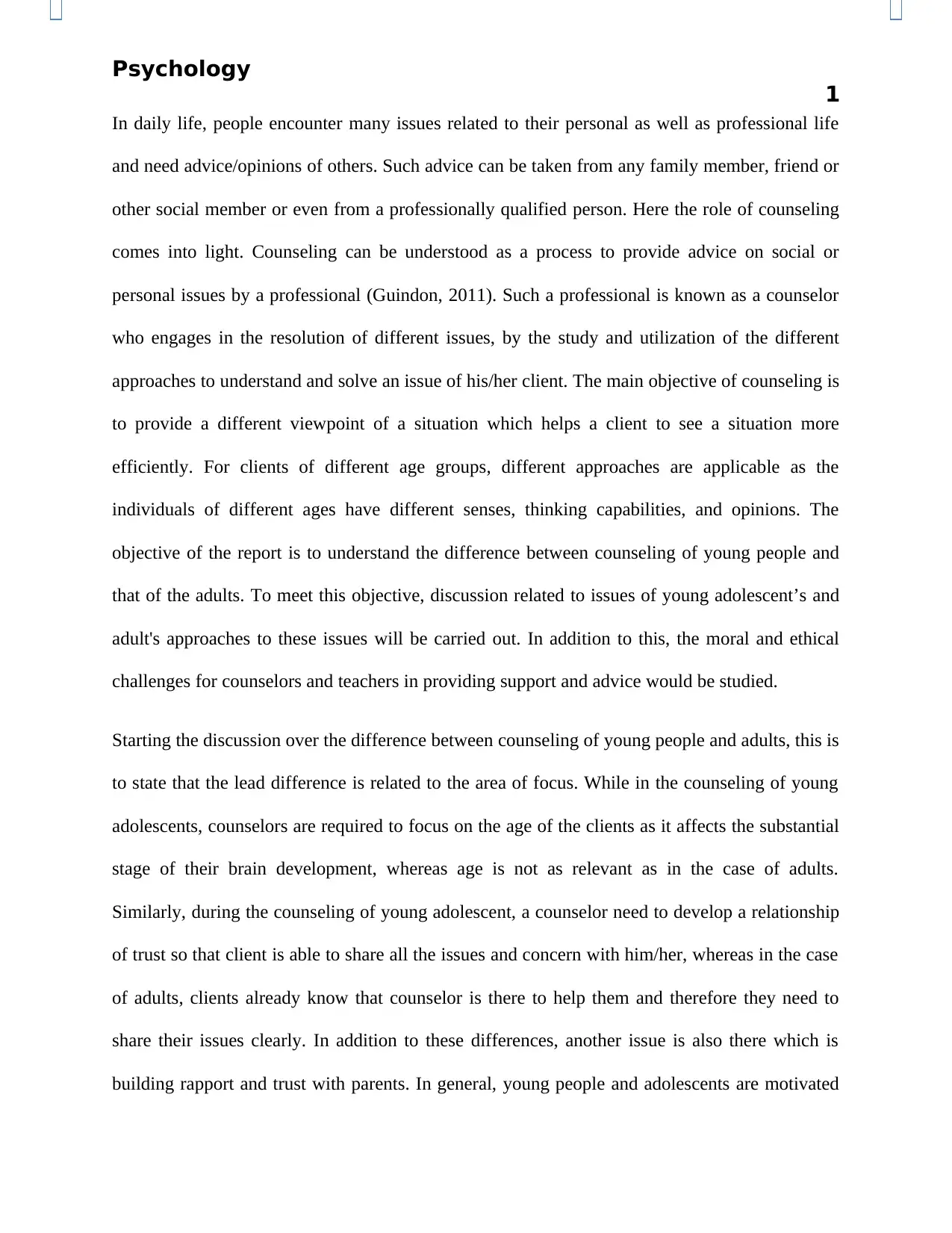
Psychology
1
In daily life, people encounter many issues related to their personal as well as professional life
and need advice/opinions of others. Such advice can be taken from any family member, friend or
other social member or even from a professionally qualified person. Here the role of counseling
comes into light. Counseling can be understood as a process to provide advice on social or
personal issues by a professional (Guindon, 2011). Such a professional is known as a counselor
who engages in the resolution of different issues, by the study and utilization of the different
approaches to understand and solve an issue of his/her client. The main objective of counseling is
to provide a different viewpoint of a situation which helps a client to see a situation more
efficiently. For clients of different age groups, different approaches are applicable as the
individuals of different ages have different senses, thinking capabilities, and opinions. The
objective of the report is to understand the difference between counseling of young people and
that of the adults. To meet this objective, discussion related to issues of young adolescent’s and
adult's approaches to these issues will be carried out. In addition to this, the moral and ethical
challenges for counselors and teachers in providing support and advice would be studied.
Starting the discussion over the difference between counseling of young people and adults, this is
to state that the lead difference is related to the area of focus. While in the counseling of young
adolescents, counselors are required to focus on the age of the clients as it affects the substantial
stage of their brain development, whereas age is not as relevant as in the case of adults.
Similarly, during the counseling of young adolescent, a counselor need to develop a relationship
of trust so that client is able to share all the issues and concern with him/her, whereas in the case
of adults, clients already know that counselor is there to help them and therefore they need to
share their issues clearly. In addition to these differences, another issue is also there which is
building rapport and trust with parents. In general, young people and adolescents are motivated
1
In daily life, people encounter many issues related to their personal as well as professional life
and need advice/opinions of others. Such advice can be taken from any family member, friend or
other social member or even from a professionally qualified person. Here the role of counseling
comes into light. Counseling can be understood as a process to provide advice on social or
personal issues by a professional (Guindon, 2011). Such a professional is known as a counselor
who engages in the resolution of different issues, by the study and utilization of the different
approaches to understand and solve an issue of his/her client. The main objective of counseling is
to provide a different viewpoint of a situation which helps a client to see a situation more
efficiently. For clients of different age groups, different approaches are applicable as the
individuals of different ages have different senses, thinking capabilities, and opinions. The
objective of the report is to understand the difference between counseling of young people and
that of the adults. To meet this objective, discussion related to issues of young adolescent’s and
adult's approaches to these issues will be carried out. In addition to this, the moral and ethical
challenges for counselors and teachers in providing support and advice would be studied.
Starting the discussion over the difference between counseling of young people and adults, this is
to state that the lead difference is related to the area of focus. While in the counseling of young
adolescents, counselors are required to focus on the age of the clients as it affects the substantial
stage of their brain development, whereas age is not as relevant as in the case of adults.
Similarly, during the counseling of young adolescent, a counselor need to develop a relationship
of trust so that client is able to share all the issues and concern with him/her, whereas in the case
of adults, clients already know that counselor is there to help them and therefore they need to
share their issues clearly. In addition to these differences, another issue is also there which is
building rapport and trust with parents. In general, young people and adolescents are motivated
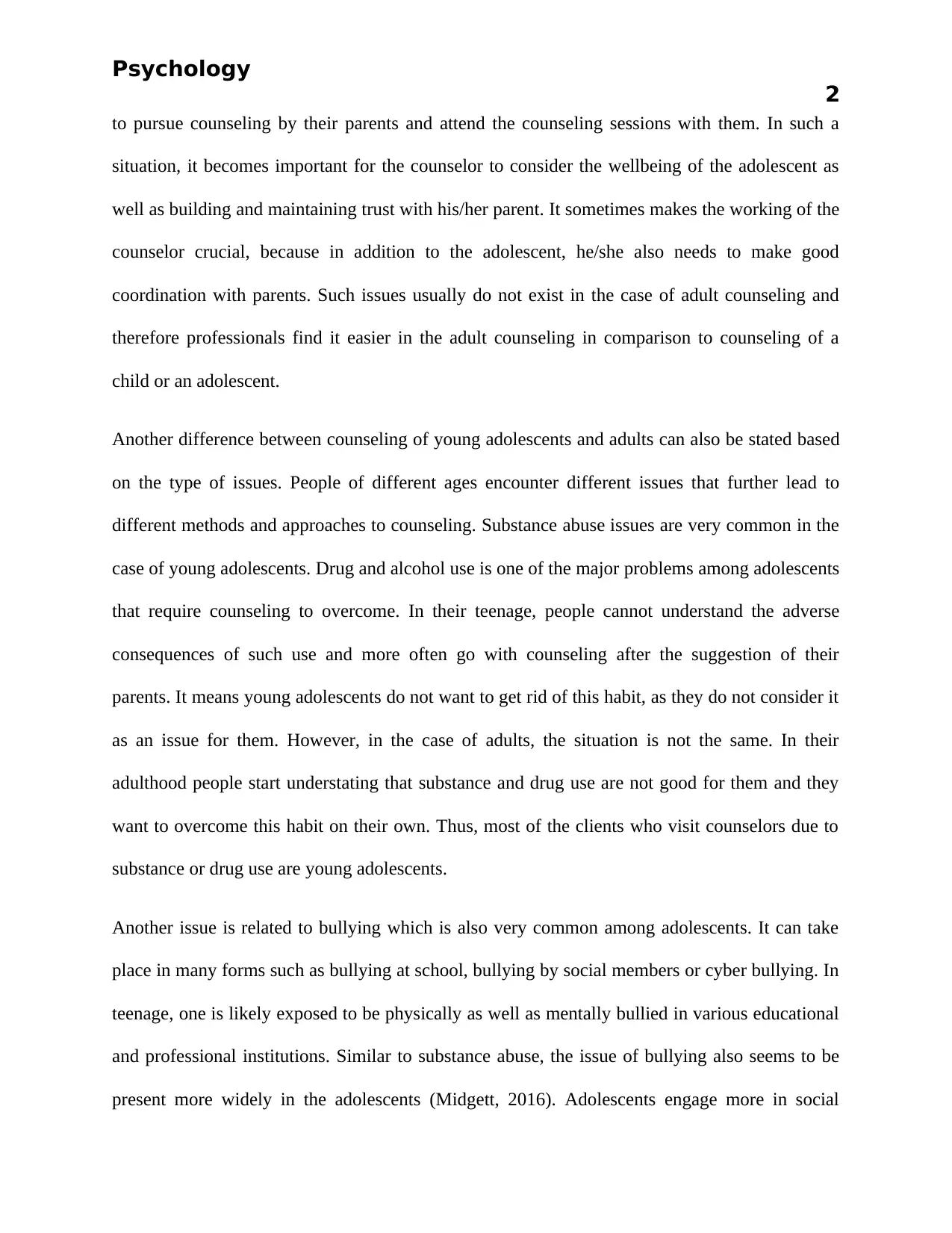
Psychology
2
to pursue counseling by their parents and attend the counseling sessions with them. In such a
situation, it becomes important for the counselor to consider the wellbeing of the adolescent as
well as building and maintaining trust with his/her parent. It sometimes makes the working of the
counselor crucial, because in addition to the adolescent, he/she also needs to make good
coordination with parents. Such issues usually do not exist in the case of adult counseling and
therefore professionals find it easier in the adult counseling in comparison to counseling of a
child or an adolescent.
Another difference between counseling of young adolescents and adults can also be stated based
on the type of issues. People of different ages encounter different issues that further lead to
different methods and approaches to counseling. Substance abuse issues are very common in the
case of young adolescents. Drug and alcohol use is one of the major problems among adolescents
that require counseling to overcome. In their teenage, people cannot understand the adverse
consequences of such use and more often go with counseling after the suggestion of their
parents. It means young adolescents do not want to get rid of this habit, as they do not consider it
as an issue for them. However, in the case of adults, the situation is not the same. In their
adulthood people start understating that substance and drug use are not good for them and they
want to overcome this habit on their own. Thus, most of the clients who visit counselors due to
substance or drug use are young adolescents.
Another issue is related to bullying which is also very common among adolescents. It can take
place in many forms such as bullying at school, bullying by social members or cyber bullying. In
teenage, one is likely exposed to be physically as well as mentally bullied in various educational
and professional institutions. Similar to substance abuse, the issue of bullying also seems to be
present more widely in the adolescents (Midgett, 2016). Adolescents engage more in social
2
to pursue counseling by their parents and attend the counseling sessions with them. In such a
situation, it becomes important for the counselor to consider the wellbeing of the adolescent as
well as building and maintaining trust with his/her parent. It sometimes makes the working of the
counselor crucial, because in addition to the adolescent, he/she also needs to make good
coordination with parents. Such issues usually do not exist in the case of adult counseling and
therefore professionals find it easier in the adult counseling in comparison to counseling of a
child or an adolescent.
Another difference between counseling of young adolescents and adults can also be stated based
on the type of issues. People of different ages encounter different issues that further lead to
different methods and approaches to counseling. Substance abuse issues are very common in the
case of young adolescents. Drug and alcohol use is one of the major problems among adolescents
that require counseling to overcome. In their teenage, people cannot understand the adverse
consequences of such use and more often go with counseling after the suggestion of their
parents. It means young adolescents do not want to get rid of this habit, as they do not consider it
as an issue for them. However, in the case of adults, the situation is not the same. In their
adulthood people start understating that substance and drug use are not good for them and they
want to overcome this habit on their own. Thus, most of the clients who visit counselors due to
substance or drug use are young adolescents.
Another issue is related to bullying which is also very common among adolescents. It can take
place in many forms such as bullying at school, bullying by social members or cyber bullying. In
teenage, one is likely exposed to be physically as well as mentally bullied in various educational
and professional institutions. Similar to substance abuse, the issue of bullying also seems to be
present more widely in the adolescents (Midgett, 2016). Adolescents engage more in social
⊘ This is a preview!⊘
Do you want full access?
Subscribe today to unlock all pages.

Trusted by 1+ million students worldwide
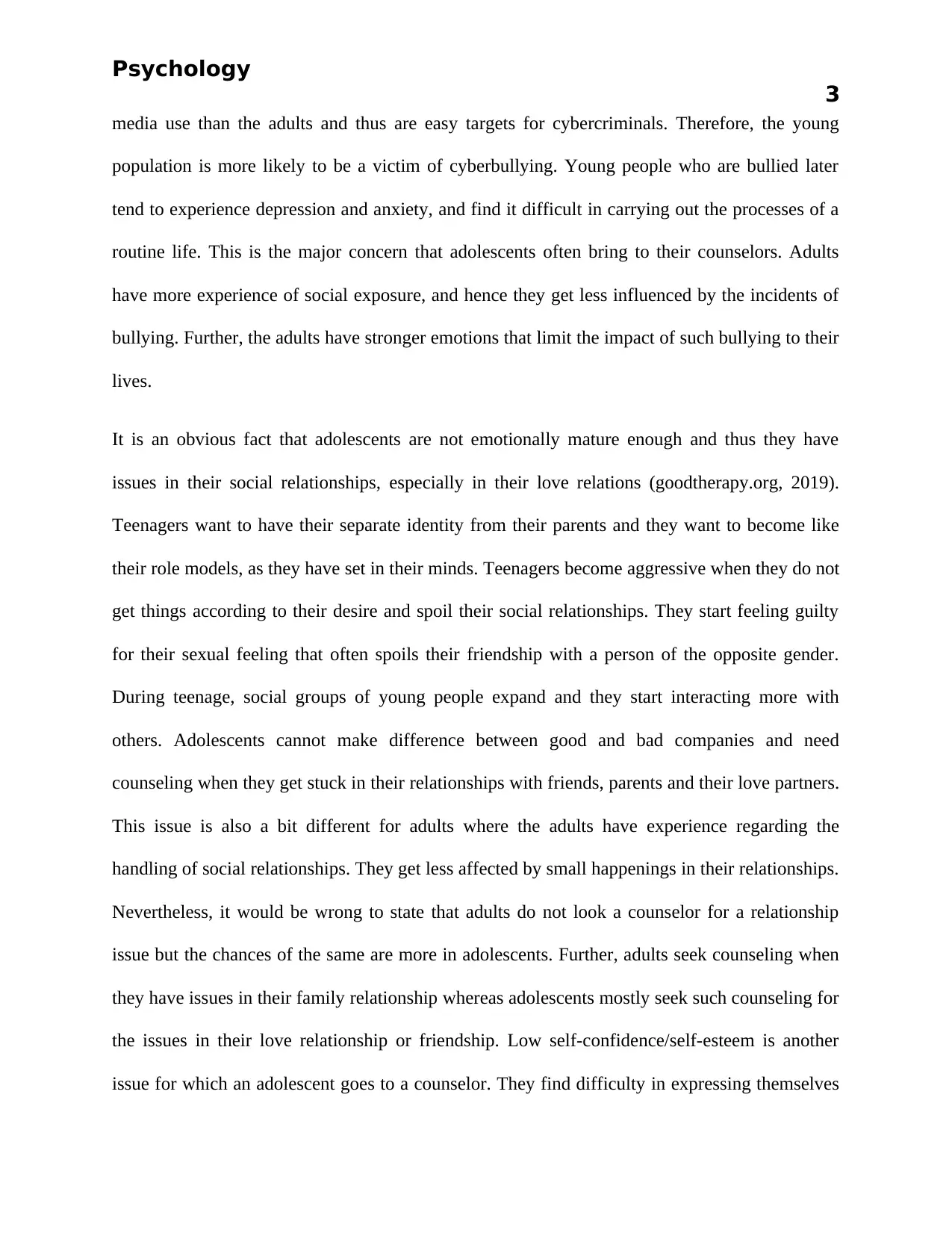
Psychology
3
media use than the adults and thus are easy targets for cybercriminals. Therefore, the young
population is more likely to be a victim of cyberbullying. Young people who are bullied later
tend to experience depression and anxiety, and find it difficult in carrying out the processes of a
routine life. This is the major concern that adolescents often bring to their counselors. Adults
have more experience of social exposure, and hence they get less influenced by the incidents of
bullying. Further, the adults have stronger emotions that limit the impact of such bullying to their
lives.
It is an obvious fact that adolescents are not emotionally mature enough and thus they have
issues in their social relationships, especially in their love relations (goodtherapy.org, 2019).
Teenagers want to have their separate identity from their parents and they want to become like
their role models, as they have set in their minds. Teenagers become aggressive when they do not
get things according to their desire and spoil their social relationships. They start feeling guilty
for their sexual feeling that often spoils their friendship with a person of the opposite gender.
During teenage, social groups of young people expand and they start interacting more with
others. Adolescents cannot make difference between good and bad companies and need
counseling when they get stuck in their relationships with friends, parents and their love partners.
This issue is also a bit different for adults where the adults have experience regarding the
handling of social relationships. They get less affected by small happenings in their relationships.
Nevertheless, it would be wrong to state that adults do not look a counselor for a relationship
issue but the chances of the same are more in adolescents. Further, adults seek counseling when
they have issues in their family relationship whereas adolescents mostly seek such counseling for
the issues in their love relationship or friendship. Low self-confidence/self-esteem is another
issue for which an adolescent goes to a counselor. They find difficulty in expressing themselves
3
media use than the adults and thus are easy targets for cybercriminals. Therefore, the young
population is more likely to be a victim of cyberbullying. Young people who are bullied later
tend to experience depression and anxiety, and find it difficult in carrying out the processes of a
routine life. This is the major concern that adolescents often bring to their counselors. Adults
have more experience of social exposure, and hence they get less influenced by the incidents of
bullying. Further, the adults have stronger emotions that limit the impact of such bullying to their
lives.
It is an obvious fact that adolescents are not emotionally mature enough and thus they have
issues in their social relationships, especially in their love relations (goodtherapy.org, 2019).
Teenagers want to have their separate identity from their parents and they want to become like
their role models, as they have set in their minds. Teenagers become aggressive when they do not
get things according to their desire and spoil their social relationships. They start feeling guilty
for their sexual feeling that often spoils their friendship with a person of the opposite gender.
During teenage, social groups of young people expand and they start interacting more with
others. Adolescents cannot make difference between good and bad companies and need
counseling when they get stuck in their relationships with friends, parents and their love partners.
This issue is also a bit different for adults where the adults have experience regarding the
handling of social relationships. They get less affected by small happenings in their relationships.
Nevertheless, it would be wrong to state that adults do not look a counselor for a relationship
issue but the chances of the same are more in adolescents. Further, adults seek counseling when
they have issues in their family relationship whereas adolescents mostly seek such counseling for
the issues in their love relationship or friendship. Low self-confidence/self-esteem is another
issue for which an adolescent goes to a counselor. They find difficulty in expressing themselves
Paraphrase This Document
Need a fresh take? Get an instant paraphrase of this document with our AI Paraphraser
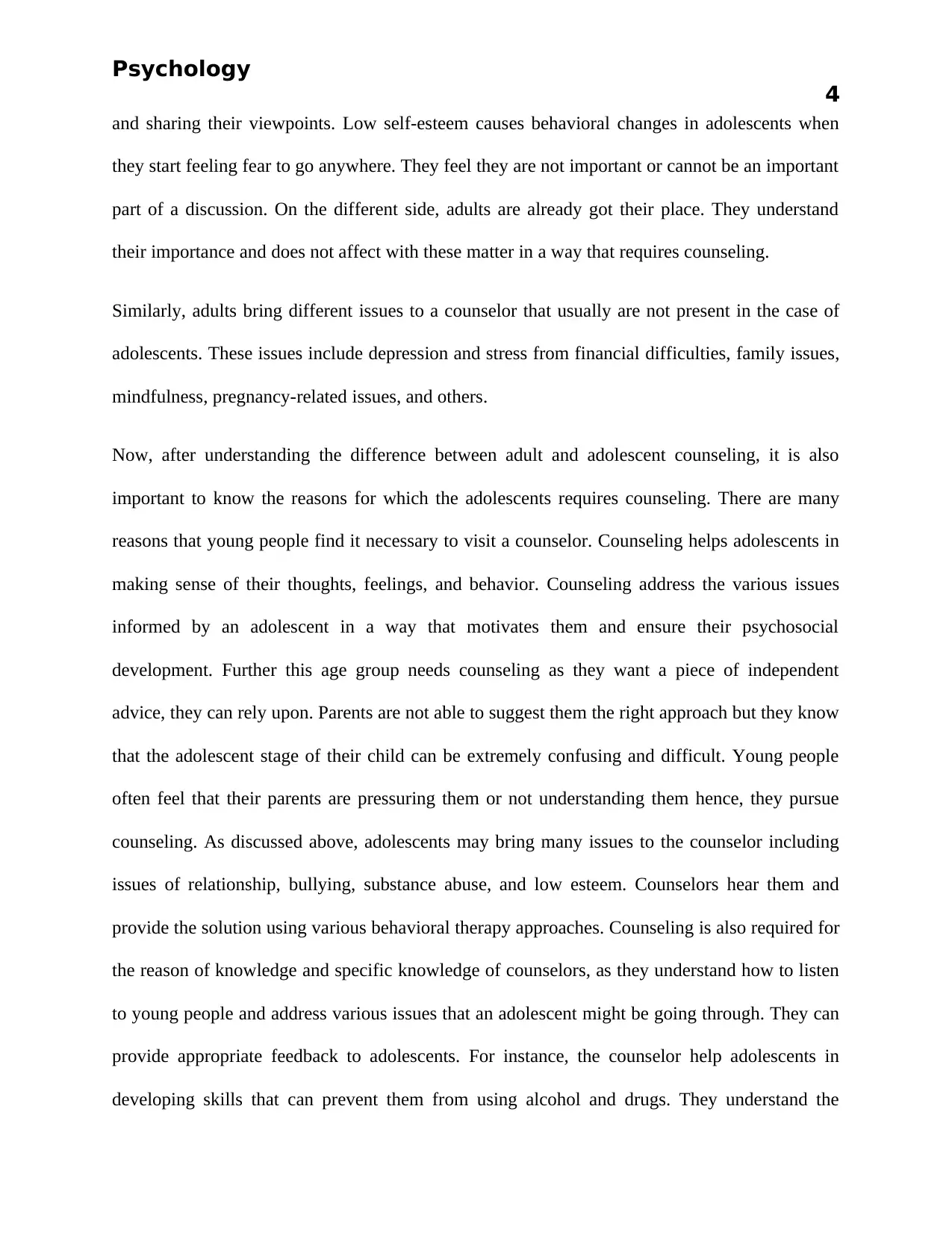
Psychology
4
and sharing their viewpoints. Low self-esteem causes behavioral changes in adolescents when
they start feeling fear to go anywhere. They feel they are not important or cannot be an important
part of a discussion. On the different side, adults are already got their place. They understand
their importance and does not affect with these matter in a way that requires counseling.
Similarly, adults bring different issues to a counselor that usually are not present in the case of
adolescents. These issues include depression and stress from financial difficulties, family issues,
mindfulness, pregnancy-related issues, and others.
Now, after understanding the difference between adult and adolescent counseling, it is also
important to know the reasons for which the adolescents requires counseling. There are many
reasons that young people find it necessary to visit a counselor. Counseling helps adolescents in
making sense of their thoughts, feelings, and behavior. Counseling address the various issues
informed by an adolescent in a way that motivates them and ensure their psychosocial
development. Further this age group needs counseling as they want a piece of independent
advice, they can rely upon. Parents are not able to suggest them the right approach but they know
that the adolescent stage of their child can be extremely confusing and difficult. Young people
often feel that their parents are pressuring them or not understanding them hence, they pursue
counseling. As discussed above, adolescents may bring many issues to the counselor including
issues of relationship, bullying, substance abuse, and low esteem. Counselors hear them and
provide the solution using various behavioral therapy approaches. Counseling is also required for
the reason of knowledge and specific knowledge of counselors, as they understand how to listen
to young people and address various issues that an adolescent might be going through. They can
provide appropriate feedback to adolescents. For instance, the counselor help adolescents in
developing skills that can prevent them from using alcohol and drugs. They understand the
4
and sharing their viewpoints. Low self-esteem causes behavioral changes in adolescents when
they start feeling fear to go anywhere. They feel they are not important or cannot be an important
part of a discussion. On the different side, adults are already got their place. They understand
their importance and does not affect with these matter in a way that requires counseling.
Similarly, adults bring different issues to a counselor that usually are not present in the case of
adolescents. These issues include depression and stress from financial difficulties, family issues,
mindfulness, pregnancy-related issues, and others.
Now, after understanding the difference between adult and adolescent counseling, it is also
important to know the reasons for which the adolescents requires counseling. There are many
reasons that young people find it necessary to visit a counselor. Counseling helps adolescents in
making sense of their thoughts, feelings, and behavior. Counseling address the various issues
informed by an adolescent in a way that motivates them and ensure their psychosocial
development. Further this age group needs counseling as they want a piece of independent
advice, they can rely upon. Parents are not able to suggest them the right approach but they know
that the adolescent stage of their child can be extremely confusing and difficult. Young people
often feel that their parents are pressuring them or not understanding them hence, they pursue
counseling. As discussed above, adolescents may bring many issues to the counselor including
issues of relationship, bullying, substance abuse, and low esteem. Counselors hear them and
provide the solution using various behavioral therapy approaches. Counseling is also required for
the reason of knowledge and specific knowledge of counselors, as they understand how to listen
to young people and address various issues that an adolescent might be going through. They can
provide appropriate feedback to adolescents. For instance, the counselor help adolescents in
developing skills that can prevent them from using alcohol and drugs. They understand the
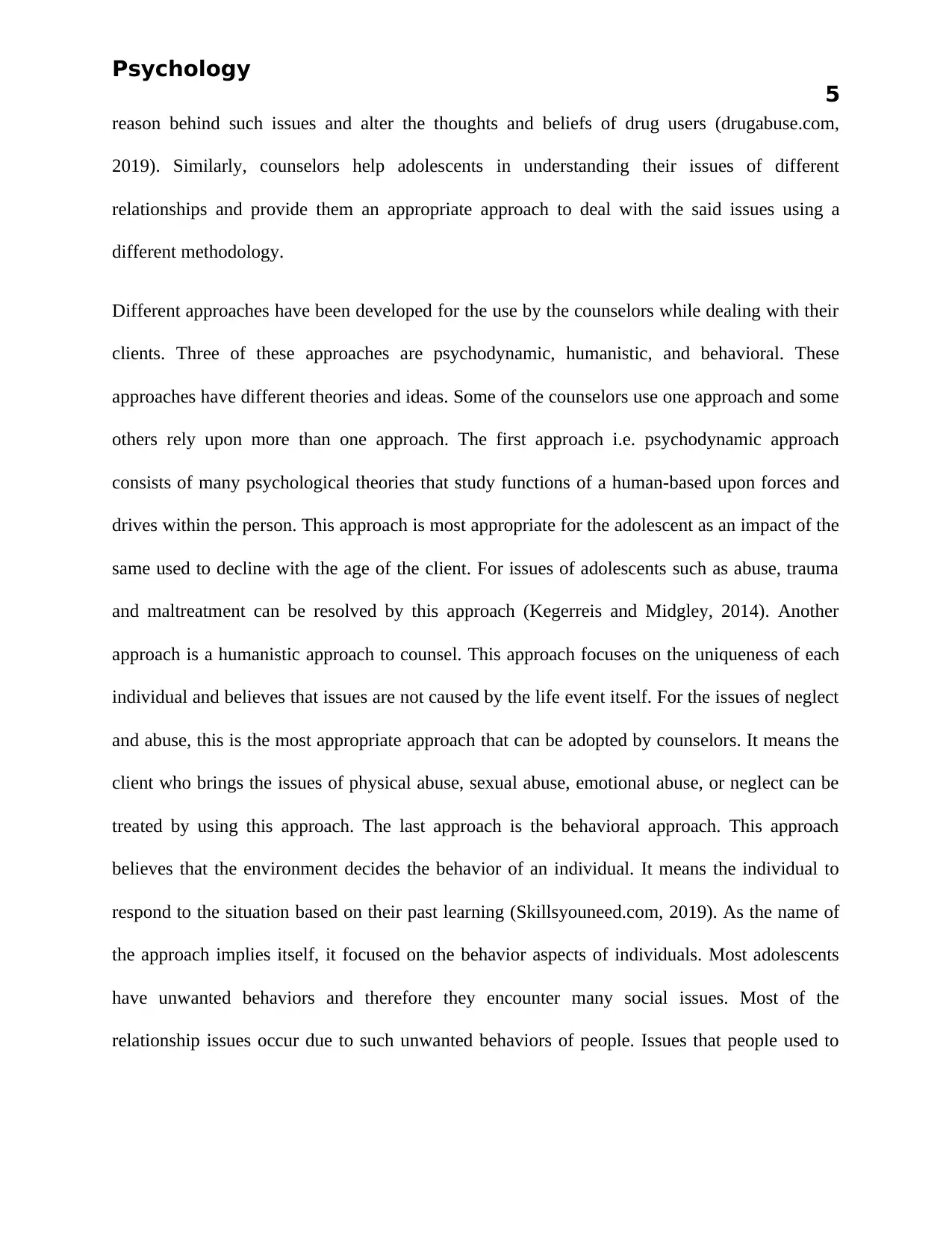
Psychology
5
reason behind such issues and alter the thoughts and beliefs of drug users (drugabuse.com,
2019). Similarly, counselors help adolescents in understanding their issues of different
relationships and provide them an appropriate approach to deal with the said issues using a
different methodology.
Different approaches have been developed for the use by the counselors while dealing with their
clients. Three of these approaches are psychodynamic, humanistic, and behavioral. These
approaches have different theories and ideas. Some of the counselors use one approach and some
others rely upon more than one approach. The first approach i.e. psychodynamic approach
consists of many psychological theories that study functions of a human-based upon forces and
drives within the person. This approach is most appropriate for the adolescent as an impact of the
same used to decline with the age of the client. For issues of adolescents such as abuse, trauma
and maltreatment can be resolved by this approach (Kegerreis and Midgley, 2014). Another
approach is a humanistic approach to counsel. This approach focuses on the uniqueness of each
individual and believes that issues are not caused by the life event itself. For the issues of neglect
and abuse, this is the most appropriate approach that can be adopted by counselors. It means the
client who brings the issues of physical abuse, sexual abuse, emotional abuse, or neglect can be
treated by using this approach. The last approach is the behavioral approach. This approach
believes that the environment decides the behavior of an individual. It means the individual to
respond to the situation based on their past learning (Skillsyouneed.com, 2019). As the name of
the approach implies itself, it focused on the behavior aspects of individuals. Most adolescents
have unwanted behaviors and therefore they encounter many social issues. Most of the
relationship issues occur due to such unwanted behaviors of people. Issues that people used to
5
reason behind such issues and alter the thoughts and beliefs of drug users (drugabuse.com,
2019). Similarly, counselors help adolescents in understanding their issues of different
relationships and provide them an appropriate approach to deal with the said issues using a
different methodology.
Different approaches have been developed for the use by the counselors while dealing with their
clients. Three of these approaches are psychodynamic, humanistic, and behavioral. These
approaches have different theories and ideas. Some of the counselors use one approach and some
others rely upon more than one approach. The first approach i.e. psychodynamic approach
consists of many psychological theories that study functions of a human-based upon forces and
drives within the person. This approach is most appropriate for the adolescent as an impact of the
same used to decline with the age of the client. For issues of adolescents such as abuse, trauma
and maltreatment can be resolved by this approach (Kegerreis and Midgley, 2014). Another
approach is a humanistic approach to counsel. This approach focuses on the uniqueness of each
individual and believes that issues are not caused by the life event itself. For the issues of neglect
and abuse, this is the most appropriate approach that can be adopted by counselors. It means the
client who brings the issues of physical abuse, sexual abuse, emotional abuse, or neglect can be
treated by using this approach. The last approach is the behavioral approach. This approach
believes that the environment decides the behavior of an individual. It means the individual to
respond to the situation based on their past learning (Skillsyouneed.com, 2019). As the name of
the approach implies itself, it focused on the behavior aspects of individuals. Most adolescents
have unwanted behaviors and therefore they encounter many social issues. Most of the
relationship issues occur due to such unwanted behaviors of people. Issues that people used to
⊘ This is a preview!⊘
Do you want full access?
Subscribe today to unlock all pages.

Trusted by 1+ million students worldwide
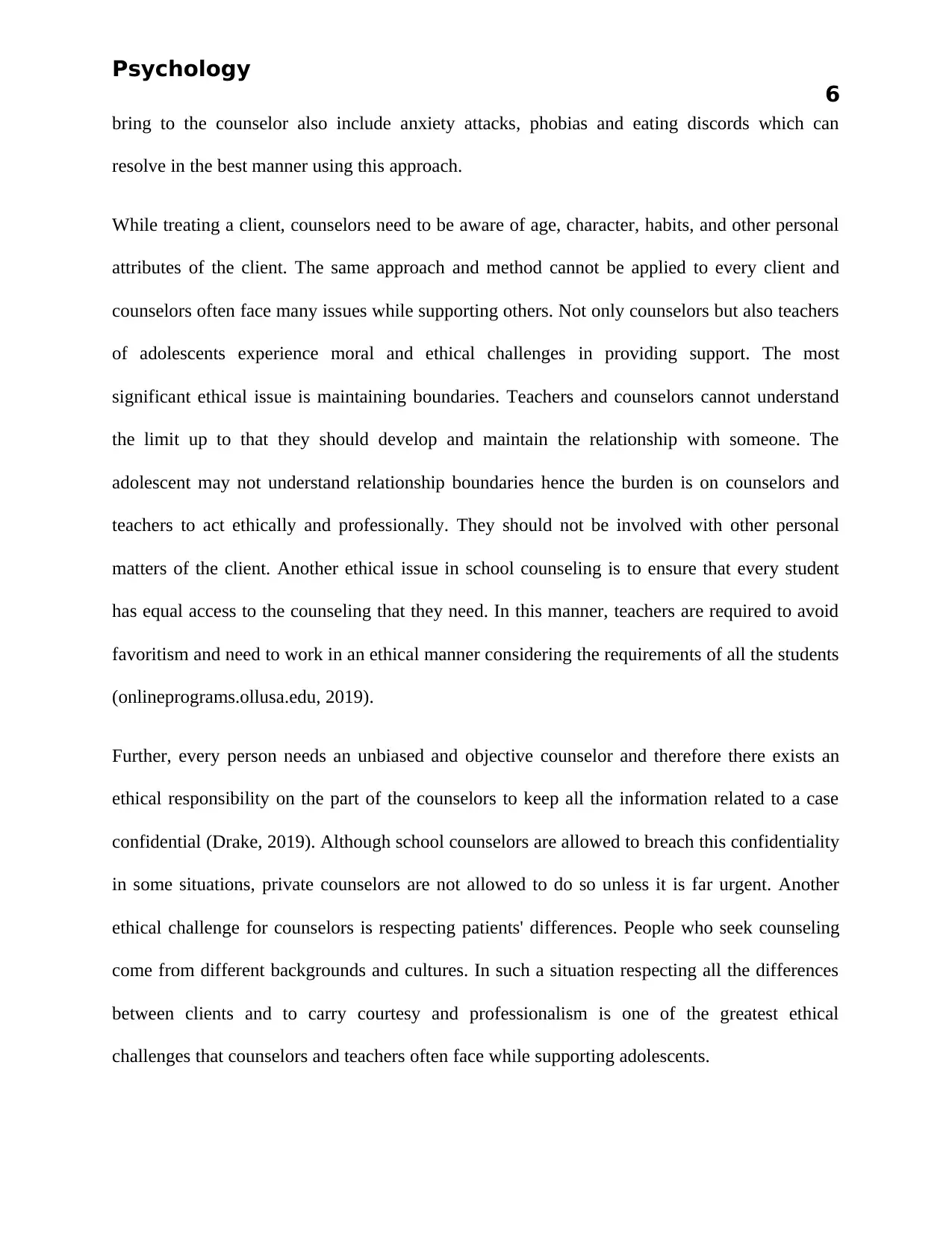
Psychology
6
bring to the counselor also include anxiety attacks, phobias and eating discords which can
resolve in the best manner using this approach.
While treating a client, counselors need to be aware of age, character, habits, and other personal
attributes of the client. The same approach and method cannot be applied to every client and
counselors often face many issues while supporting others. Not only counselors but also teachers
of adolescents experience moral and ethical challenges in providing support. The most
significant ethical issue is maintaining boundaries. Teachers and counselors cannot understand
the limit up to that they should develop and maintain the relationship with someone. The
adolescent may not understand relationship boundaries hence the burden is on counselors and
teachers to act ethically and professionally. They should not be involved with other personal
matters of the client. Another ethical issue in school counseling is to ensure that every student
has equal access to the counseling that they need. In this manner, teachers are required to avoid
favoritism and need to work in an ethical manner considering the requirements of all the students
(onlineprograms.ollusa.edu, 2019).
Further, every person needs an unbiased and objective counselor and therefore there exists an
ethical responsibility on the part of the counselors to keep all the information related to a case
confidential (Drake, 2019). Although school counselors are allowed to breach this confidentiality
in some situations, private counselors are not allowed to do so unless it is far urgent. Another
ethical challenge for counselors is respecting patients' differences. People who seek counseling
come from different backgrounds and cultures. In such a situation respecting all the differences
between clients and to carry courtesy and professionalism is one of the greatest ethical
challenges that counselors and teachers often face while supporting adolescents.
6
bring to the counselor also include anxiety attacks, phobias and eating discords which can
resolve in the best manner using this approach.
While treating a client, counselors need to be aware of age, character, habits, and other personal
attributes of the client. The same approach and method cannot be applied to every client and
counselors often face many issues while supporting others. Not only counselors but also teachers
of adolescents experience moral and ethical challenges in providing support. The most
significant ethical issue is maintaining boundaries. Teachers and counselors cannot understand
the limit up to that they should develop and maintain the relationship with someone. The
adolescent may not understand relationship boundaries hence the burden is on counselors and
teachers to act ethically and professionally. They should not be involved with other personal
matters of the client. Another ethical issue in school counseling is to ensure that every student
has equal access to the counseling that they need. In this manner, teachers are required to avoid
favoritism and need to work in an ethical manner considering the requirements of all the students
(onlineprograms.ollusa.edu, 2019).
Further, every person needs an unbiased and objective counselor and therefore there exists an
ethical responsibility on the part of the counselors to keep all the information related to a case
confidential (Drake, 2019). Although school counselors are allowed to breach this confidentiality
in some situations, private counselors are not allowed to do so unless it is far urgent. Another
ethical challenge for counselors is respecting patients' differences. People who seek counseling
come from different backgrounds and cultures. In such a situation respecting all the differences
between clients and to carry courtesy and professionalism is one of the greatest ethical
challenges that counselors and teachers often face while supporting adolescents.
Paraphrase This Document
Need a fresh take? Get an instant paraphrase of this document with our AI Paraphraser
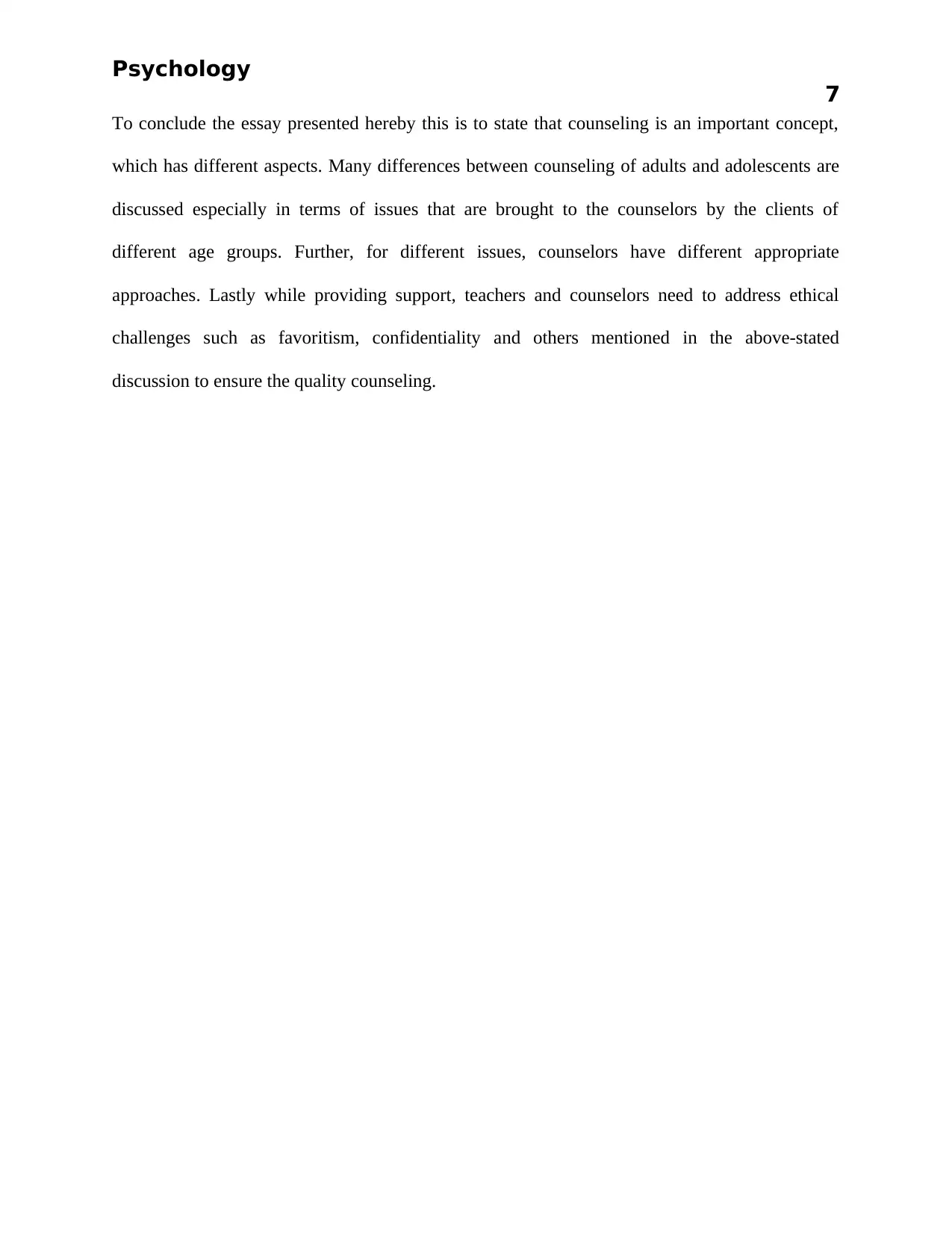
Psychology
7
To conclude the essay presented hereby this is to state that counseling is an important concept,
which has different aspects. Many differences between counseling of adults and adolescents are
discussed especially in terms of issues that are brought to the counselors by the clients of
different age groups. Further, for different issues, counselors have different appropriate
approaches. Lastly while providing support, teachers and counselors need to address ethical
challenges such as favoritism, confidentiality and others mentioned in the above-stated
discussion to ensure the quality counseling.
7
To conclude the essay presented hereby this is to state that counseling is an important concept,
which has different aspects. Many differences between counseling of adults and adolescents are
discussed especially in terms of issues that are brought to the counselors by the clients of
different age groups. Further, for different issues, counselors have different appropriate
approaches. Lastly while providing support, teachers and counselors need to address ethical
challenges such as favoritism, confidentiality and others mentioned in the above-stated
discussion to ensure the quality counseling.
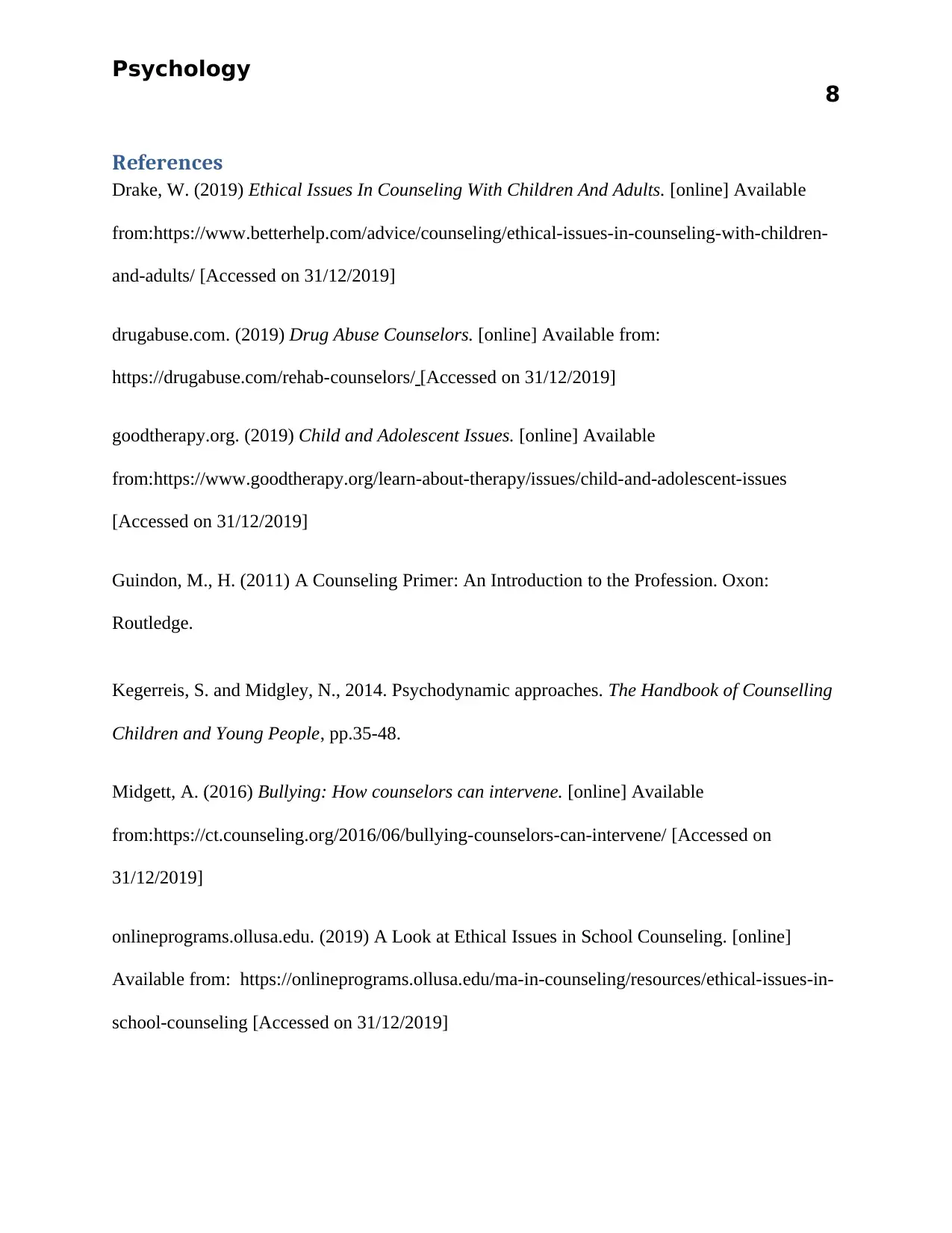
Psychology
8
References
Drake, W. (2019) Ethical Issues In Counseling With Children And Adults. [online] Available
from:https://www.betterhelp.com/advice/counseling/ethical-issues-in-counseling-with-children-
and-adults/ [Accessed on 31/12/2019]
drugabuse.com. (2019) Drug Abuse Counselors. [online] Available from:
https://drugabuse.com/rehab-counselors/ [Accessed on 31/12/2019]
goodtherapy.org. (2019) Child and Adolescent Issues. [online] Available
from:https://www.goodtherapy.org/learn-about-therapy/issues/child-and-adolescent-issues
[Accessed on 31/12/2019]
Guindon, M., H. (2011) A Counseling Primer: An Introduction to the Profession. Oxon:
Routledge.
Kegerreis, S. and Midgley, N., 2014. Psychodynamic approaches. The Handbook of Counselling
Children and Young People, pp.35-48.
Midgett, A. (2016) Bullying: How counselors can intervene. [online] Available
from:https://ct.counseling.org/2016/06/bullying-counselors-can-intervene/ [Accessed on
31/12/2019]
onlineprograms.ollusa.edu. (2019) A Look at Ethical Issues in School Counseling. [online]
Available from: https://onlineprograms.ollusa.edu/ma-in-counseling/resources/ethical-issues-in-
school-counseling [Accessed on 31/12/2019]
8
References
Drake, W. (2019) Ethical Issues In Counseling With Children And Adults. [online] Available
from:https://www.betterhelp.com/advice/counseling/ethical-issues-in-counseling-with-children-
and-adults/ [Accessed on 31/12/2019]
drugabuse.com. (2019) Drug Abuse Counselors. [online] Available from:
https://drugabuse.com/rehab-counselors/ [Accessed on 31/12/2019]
goodtherapy.org. (2019) Child and Adolescent Issues. [online] Available
from:https://www.goodtherapy.org/learn-about-therapy/issues/child-and-adolescent-issues
[Accessed on 31/12/2019]
Guindon, M., H. (2011) A Counseling Primer: An Introduction to the Profession. Oxon:
Routledge.
Kegerreis, S. and Midgley, N., 2014. Psychodynamic approaches. The Handbook of Counselling
Children and Young People, pp.35-48.
Midgett, A. (2016) Bullying: How counselors can intervene. [online] Available
from:https://ct.counseling.org/2016/06/bullying-counselors-can-intervene/ [Accessed on
31/12/2019]
onlineprograms.ollusa.edu. (2019) A Look at Ethical Issues in School Counseling. [online]
Available from: https://onlineprograms.ollusa.edu/ma-in-counseling/resources/ethical-issues-in-
school-counseling [Accessed on 31/12/2019]
⊘ This is a preview!⊘
Do you want full access?
Subscribe today to unlock all pages.

Trusted by 1+ million students worldwide

Psychology
9
Skillsyouneed.com, (2019) Approaches to Counselling. [online] Available from:
https://www.skillsyouneed.com/learn/counselling-approaches.html [Accessed on 31/12/2019]
9
Skillsyouneed.com, (2019) Approaches to Counselling. [online] Available from:
https://www.skillsyouneed.com/learn/counselling-approaches.html [Accessed on 31/12/2019]
1 out of 10
Related Documents
Your All-in-One AI-Powered Toolkit for Academic Success.
+13062052269
info@desklib.com
Available 24*7 on WhatsApp / Email
![[object Object]](/_next/static/media/star-bottom.7253800d.svg)
Unlock your academic potential
Copyright © 2020–2025 A2Z Services. All Rights Reserved. Developed and managed by ZUCOL.





